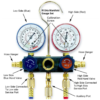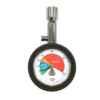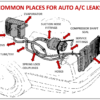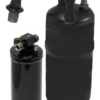Mr. Fixit: DIY vs Take it to the Shop?
Have you ever experienced a sweltering day where you started your vehicle, cranked the A/C and a few moments later realized it’s simply not generating cold air? It’s happened to most of us at one point or another. But what do you do about it? Live without A/C? Drive directly to your local shop or dealership? Or do you walk into an auto parts store and buy a DIY recharge kit? A vehicle without A/C can be unpleasant, and a properly working A/C can keep everyone in the car comfortable during hot seasons.
There is a segment of the population who is willing to live without A/C for the short term, especially if the weather is starting to cool off. Others have a newer vehicle, under warranty, which they will bring back to the dealership from which they purchased it. That leaves the rest of us with a choice to make: DIY or shop. Oftentimes the choice to DIY is governed by one or two criteria: either you are a “hands on person” who feels completely at ease working on your own vehicle, or you are looking to save some money on the cost of repairs.
If your system just needs a simple recharge, a DYIer should plan to spend somewhere between $10 to $50 for a can of refrigerant with a charging tool (more if your vehicle uses R-1234yf refrigerant). These are available as a complete kit, or can be purchased separately. Most of the difference in pricing stems from the quality of the charging tool (and whether it is reusable), the size of the can, and the addition of any additives to the refrigerant (leak sealer, dye, performance booster, etc.).
By contrast, at an independent repair shop a simple A/C charge, without any other repairs would likely cost between $89 to $249 or between $250—$500 at a dealership. Before your A/C is charged, the tech will likely ask about what led up to the A/C failure and visually inspect the system components for leaks or damage. Most repair shops will determine whether your fans are working, that the compressor clutch is engaging and will check the pressure readings from both sides of your system (expect to incur labor charges for all of these diagnostics). If no damage or leaks are found, the refrigerant will be evacuated from the vehicle and the appropriate amount will be added back in, using manufacturer’s guidelines for your vehicle. If damage or a leak IS found, the repair will likely be a much larger expenditure, potentially replacing expensive system components.
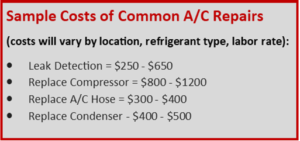
Bear in mind, loss of A/C output is indicative of a larger issue (usually a leak or component failure), and “topping off” your refrigerant doesn’t address that issue. However, if you have a slow leak it may be a cost-effective way to get through a season without a costly repair bill. Many choose the DIY option as a first course, but if the issue does not resolve—or returns within a few weeks—it might be time to bring it into the repair shop.
LMK 2021


